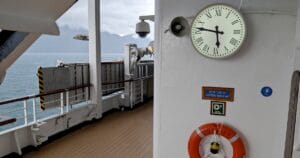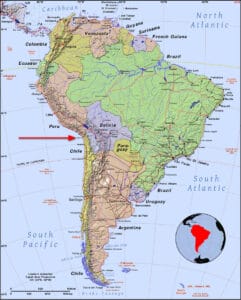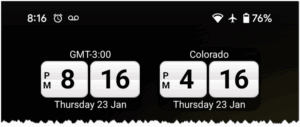What time is it? Time to answer one of the most-asked questions. Seriously!
“Do you just operate on GMT? (Greenwich Mean Time, aka ‘Zulu’ time.)” Definitely not.
“Do you do Daylight Saving Time?” Depends!
OK: to answer the question, ships start on local time — the time it is at the port where you board. Makes sense.
The difficulty comes in when we travel east or west, and cross into a different time zone. Then what?
That is the real question.
Practicalities
The real answer is, ship time is what the captain says it is. But captains operate on common sense.

When a port expects us to arrive at 8:00 a.m., they don’t mean Zulu, and they certainly don’t mean whatever time it might be according to the departure port.
Not surprisingly, they mean 8:00 a.m. their time, and they’ll have tugboats, harbor pilots, and border security folks scheduled to be there at that time so you can get there and go ashore. If you don’t arrive on time (their time) and they have to wait, guess who gets overtime, and guess who pays for it?
So then the real question is, at what point does the ship change its clock if there’s a time zone change between the departure port and the next destination?
Time Zones
The real answer is, ship time is what the captain says it is. But captains operate on common sense.
The captain knows the residents need to be on the “local time” of where they’re going. That’s necessary for catching a tour, having a meal ashore, meeting friends that might live there, etc. But the ship started in a different time zone.
What to do? On the day the ship crosses the time zone, the ship’s time zone will change, almost always at 2:00 a.m., just as it’s done for the change into/out of Daylight Saving Time in the U.S. (and many other countries).
Simple!
Except.
Except?
Sometimes exceptions are made. As we were coming down the west coast of South America, we learned that when we crossed from Peru to Chile (arrow on map), the time would change.

Your first reaction might be, “But we’re going south! How could it change?” But look at the map: as you go south along Peru’s coast, you’re moving east — especially in the southern half. As we were heading to Arica, at Chile’s northern edge, we knew the time zone would change at the border.
The thing is, it changed by two hours. Not only is coastal Chile farther east than coastal Peru, but Chile recognizes DST, and Peru does not. It’s summer in the southern hemisphere, so the net result is a two-hour time difference.
The onboard staff works long hours. Taking two hours out of their schedule means they lose two hours of sleep. One hour is bad enough. Residents can just sleep late; not the housekeeping, food services, etc. staff!
So yes, the ship recognizes DST …if, and only if, the destination does.
Captain’s Prerogative
The time is what the captain says it is. To help the staff, the captain declared that the time would change by two hours at 8:00 p.m. the evening before arriving at the first port in Chile, Arica. Thus, per captainly decree, at 8:00 p.m. the onboard time suddenly became 10:00 p.m. That way the daytime staff could go off duty both “on time” and “early” …at the same time. They could get a full sleep.
That’s the captain taking care of his crew. That’s why it needs to be up to the captain: policy might be handy, but he has the prerogative to make exceptions to put the well being of the crew higher in priority. They had to get up at their regular time no matter when they went to bed, but they got to go to bed two hours earlier than if the clock had changed at 2:00 a.m.
We residents highly approve of the captain taking care of the people who take care of us.
So yes, “What time is it?” is a bit more complex when your home moves around the world. But don’t worry: unlike the way it is in most of the world, common sense prevails. Part of the job of a captain is to have sense, even if such a thing is uncommon.
Ship time is is what the captain says it is, and thank goodness he has common sense!
Updates!
Clearly I didn’t anticipate all the questions on this subject!
How how do you know what time it is on the ship? Are there clocks everywhere that get changed via some master control?
There are some clocks around the ship, but rarely is there one in view when I want to know the time. When the ship time is to change (again, usually at 2:00 a.m.), a laminated card ends up on our cabin doors to let us know it’s going +1 hour, or –1 hour.

My procedure is to manually change my phone’s time, and the easiest way to do that is by setting the GMT after turning off automatic time zones (which are set by the nearest cell tower, which are few and far between in the ocean). My phone has two clocks so I know local and Colorado times.

My computer remains on Colorado time (the “official time” of my business), so I have a clue as to what my deadlines are. I have a second clock on my computer, too.
How often do you change time zones? How many time zone changes have there been since you boarded?
Depends on whether you’re mostly going east-west, or north-south, and what countries you’re going to. There are exceptions there, too. NW Spain is Central European Time (GMT+1); Portugal, directly south, is GMT. Swing around and go into Seville? Back to CET. Down to Morocco: back to GMT+1. Etc.
Harder is going across the Atlantic from Africa to the Caribbean — 5 time zone changes, an hour every night or two.
The answer to how many times we’ve changed in the past 115 days? I don’t know: I didn’t even try to keep track.
Related: Party Like There’s No Tomorrow (International Date Line)
Originally Published January 23, 2025 — Last Updated September 3, 2025

Common sense. What a great way to run…well, anything. 🙂
—
Hear hear. -rc
This one is fascinating. Now how do you know what time it is on the ship? Are there clocks everywhere that get changed via some master control? How about your computer and phone? I would estimate 90% or more of the time when I want to know what time it is, I look in the lower right corner of my computer screen, or pull my phone out of my pocket. Last question and I’ll leave you alone — how often do you change time zones? How many time zone changes have there been since you boarded?
Really love these updates, it’s rather fun vicariously sailing the world with you and Kit.
—
I’ll add an update to the article. -rc
Very interesting information on a subject that I’d never considered before. I cross the continent (NA) twice every year, but I drive so the time change only happens one hour at a time on non-consecutive days. It’s great to see that someone in authority uses “COMMON SENSE”, particularly when looking out for those under his command.
I find it fascinating to follow the route that y’all are taking down the west coast of South America. It reminds me of taking the Alaska Marine Highway along the state’s coast. Weaving through the islands of BC and Alaska is pure joy!
I did that some years ago. You are so right: Pure joy! Beautiful country, blue water, green everywhere and the blue sky! I’d do it again.
—
I’d definitely enjoy the Chilean Fjords again. And good thing: they put it on the schedule again for 2028! Obviously still very tentative, of course. -rc
Wow! Confusing. It makes sense just follow The Captain. He says what he says! Keep on cruising! I really enjoy the articles in RC. Thanks!
A well thinking Captain. Hooray for all of you. I would also suspect that the person in charge has had the experience of changing “ship” time more than once during their career. A manager doing their best to take care of their “troops.” What a tremendous concept!
I had the good fortune to work for a few people like that and some that did not even begin to understand that concept. Happy to hear that you are exposed to the former as opposed to the latter.
On one cruise, eastbound from Austrailia to the US, our ship’s captain declared that the clocks would move forward at noon => 1pm. Made for a short lunch, but we all got the regular amount of sleep. I liked that approach.
From aboard the Regent Mariner off the coast of Brazil.
—
Captains may differ. 🙂 -rc
Each time you cross into a new time zone, the captain should just play Chicago’s “Does Anybody Really Know What Time It Is?” over the ship’s PA. Boom, announcement made!
It’s 25 or 6 to 4! LOL
—
Dammit, Bill! Now I have a guitar solo playing in my head. -rc
Wow. What a topic. Personally, I think I would just go by my stomach. Lol
—
You might go by your stomach, but the food service folks go by the clock. You will miss out! -rc
Randy, you always write a good story often enhanced by graphics and/or photos. I’m particularly charmed by the map (and its details) in this article. Can you share its source?
Keep on writing.
—
Not offhand, which is to say nothing more than what’s printed on it. It’s public domain. -rc
When we were returning from Spain to Southampton, we were still on Spain time. Spain uses Central European time (UTC+1, plus one for summer) even though geographically it ranges from UTC-1 to UTC+0, plus one for summer. We were off its west coast, so we were two hours west of our nominal time zone. Plus it was summer. Net, we were on UTC+2 and the sun was on UTC-1, so ship time was three hours off of solar time.
“Off sun time” … oh, wow, the stories I could share on this one! Possibly the most extreme is this one. One morning watch I was on the bridge on a Navy ship patrolling in the Persian Gulf (some years ago). Although it was about 3 a.m. (on our clocks) it was well past sunrise. A ship was spotted and it was determined that it would pass within a certain distance from us. Safe, never less than 4 miles away, but protocol demanded the Captain be informed as soon as possible if that was going to be less than 5 miles, so I dutifully called him. (This was a routine thing, really.) I gave him my report including something that the ship was then, oh, 20 or so miles distant, on such-and-such a heading and would come no closer than 4 miles to us at the closest point.
A sleepy Captain replied “What do his lights look like?” meaning, visually, can you determine what direction is he pointing based on his navigation lights configuration, and does this information confirm what you have worked out from the radar scope. Since it was broad daylight, I could see the ship quite clearly and I started to reply, “Captain, he’s not showing any lights…” and the quite startled Captain was on the bridge even before I said “…because it is daylight out here” into the phone!
—
And a few hours later, the captain changed ship time ahead by 5 hours. 🙂 -rc
👍🏼 there were operational reasons to not make this change.
For some reason, after reading this article specifically, I realized that this ship has covered a lot of ground already! Would love to see a map of its plans for the next two and a half years.
—
The one I have is woefully out of date, but “Pretty much everywhere a cruise ship of its size can go.” -rc
It’s not a map, and I don’t know how good it is for the future, but the spreadsheet that you can get from https://villavieresidences.com, on the ITINERARY tab, DOWNLOAD ODYSSEY ITINERARY has them in the right place today. It was updated a week and a half ago. (I’m not giving a direct link because they seem to use a new name every time they update it.)
There’s maps without dates on the ITINERARY / ODYSSEY ITINERARY page. There’s also a Google Earth view (without dates) there that looks at least plausible; it certainly shows the flavor.
When in the Navy, we typically departed port on local time and set out at once to adjust ship’s clocks to the local time of the destination. DST or not depending on local port’s habits. We would do this by subtracting an hour every other night (or nightly, if needed) at 2:00 a.m. ship’s time. 2:00 a.m. became 3:00 a.m, thus shortening the “long” midwatch. When we needed to add time, we usually added it during the evening dog watches. The four hour watch 4:00 p.m. to 8:00 p.m. is often broken into two 2-hour watches. This affords better eating schedules and less stress on the galley. It also meant the watch rotation slipped by one watch each day. Nobody got stuck on the midwatch for many days in a row. It made better sense to stretch a 2-hour watch to three hours than to make the already dreaded midwatch five hours long.
How sensible it is to look after the staff. Without them, let’s face it, you are all up the creek! Fascinating reading, and things that I doubt any of us would think about…unless of course you are there experiencing it!
I love this, it’s so cool.
We are in France (skiing) at the moment so just an hour ahead of Ireland, the weather’s fab, the snow is great and we are having the best time, we hope you are too, and we look forward to the next installment of Residential Cruising.
Jules Vern’s “Around the World in 80 Days” brings up a further interesting conundrum about time zones, and published in 1872, deals with relativity, 20 years before Einstein published his theory of relativity.
That he managed to treat such a science theory so much earlier than Einstein boggles my mind.
The surprise ending involves the circumstance that, while 81 days elapse for Phileas Fogg as he traveled around the world, who assumes he has lost the bet, those who remained behind in London have only experienced 80 days, and they congratulate him for having won the bet.
Astounding.
—
Clever plotting and writing, absolutely. Astounding example of Einstein’s Special Relativity, no. The Fictional Fogg’s experience does not deal with the physical implications of velocity and gravity on the flow of time, but to the consequences of crossing the International Date Line and how that affects the tracking of days during travel. The concept of the IDL well predates Verne, and probably was well known to him to have used it in the plot in this way. Sorry to burst that bubble! -rc
This reminded me of my first deployment, ages ago.
The common practice was to adjust the clocks just after midnight, often 1 AM. Heading east at 1, it suddenly became 2 AM, so working days I lost an hour of sleep. No problem. Then on the return crossing the Atlantic and working nights, I gained an hour on my watch, while others gained an hour of sleep. But don’t worry too much about it, since we were preparing for a big engineering exam and no one in the engineering department got as much sleep as they were previously accustomed to. Ah, to be young again and able to work when sleep deprived.
This reminds me of the time (late 60s or early 70s) when my uncle was working for Shell Tankers and they began computerising the ships’ logs, with a built-in check that the total hours logged in every week must add up to 168 (7×24).
Needless to say, every report that crossed his desk was marked REJECTED!
Don’t know how many of these spots you’ll visit on your cruise, but there are over a dozen areas on the globe where the time change is offset by 30 or 45 minutes from its zone. India is one of them, Venezuela is another.
—
Venezuela is under a “do not travel” advisory from the U.S. Dept. of State, so it’s not currently in our lineup. But we’ll be in and out of India quite a bit late next year. No doubt we’ll match their time zones, and it reinforces the good idea for me to keep my computer on Colorado time! -rc
Though initially hesitant to pose my question I am thrilled that your information laden response helped others and opened up what I hope will be an ongoing discussion.
—
It’s an entirely new travel sector, so there are definitely going to be a lot of questions! A lot are answered among the articles here. It doesn’t hurt to go to the first one, and then at least skim through to each one using the navigation links under the Author’s Box. -rc
It still makes more sense than the time zones in Indiana.
—
😆 -rc